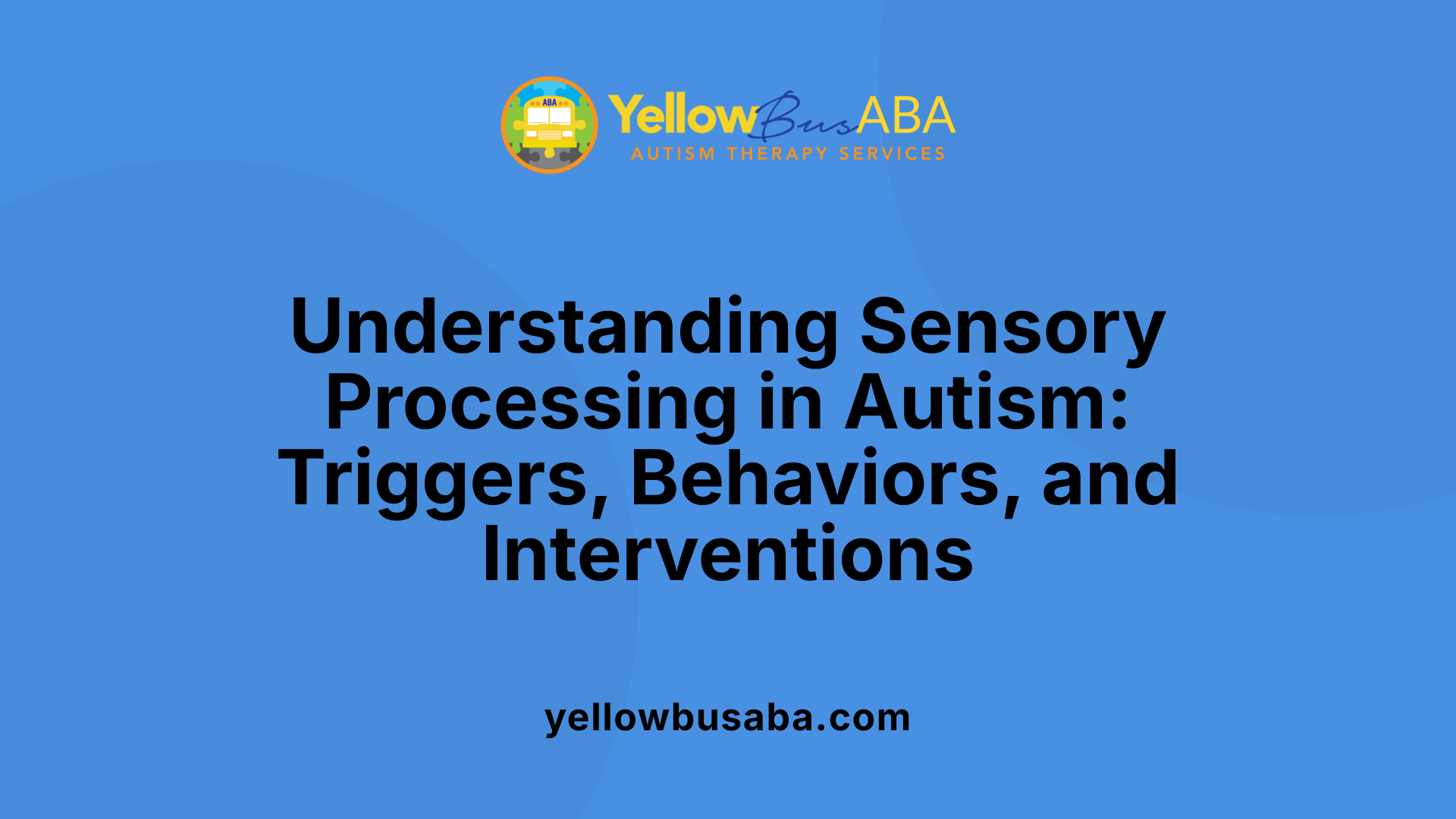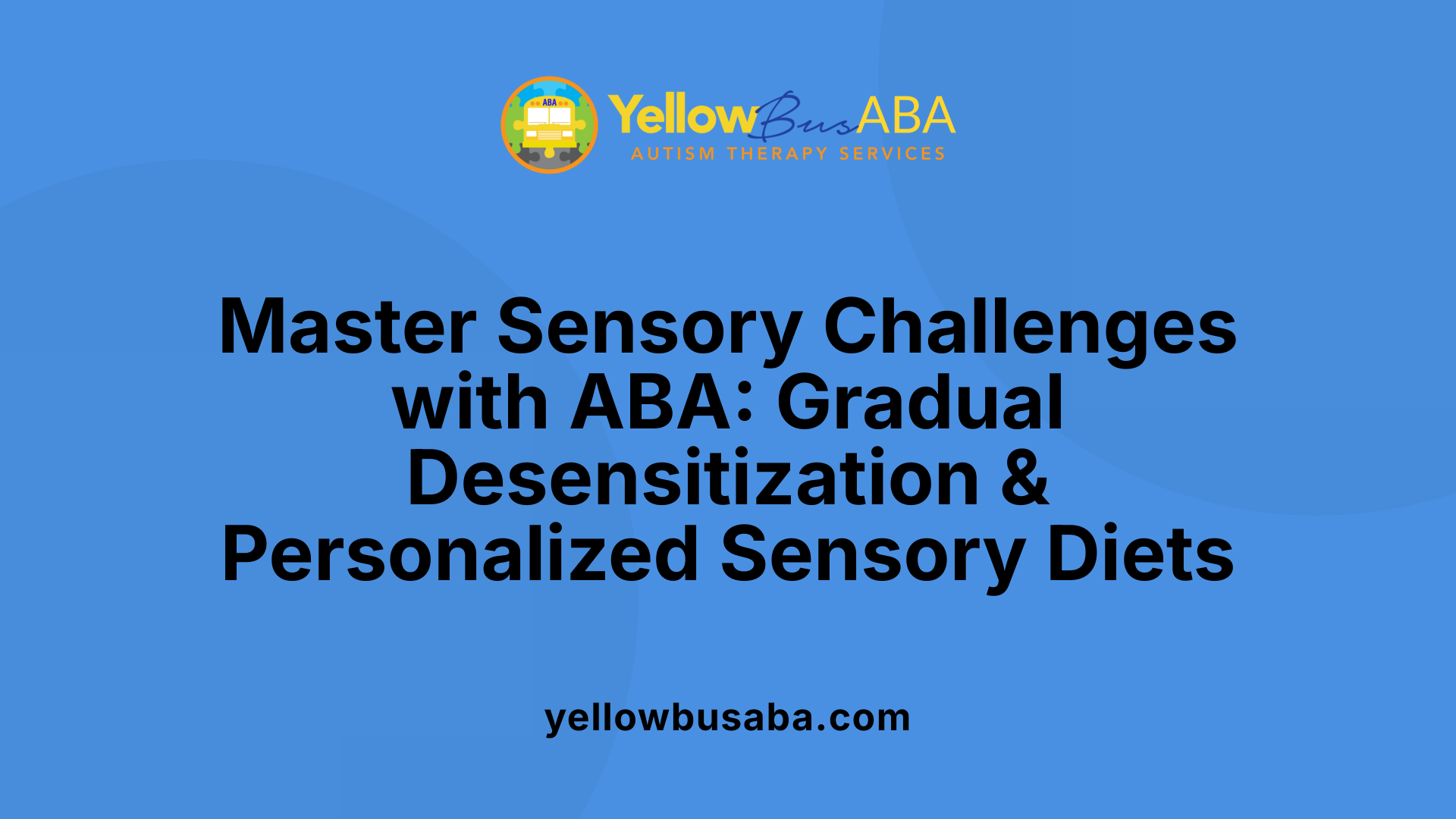Supporting Children with Autism in Overcoming Sensory Challenges through ABA Therapy
October 29, 2025
Enhancing Sensory Processing in Children with Autism through Tailored ABA Strategies

Understanding Sensory Challenges in Autism and the Role of ABA Therapy
Children with autism often face significant sensory processing challenges, impacting their daily functioning and quality of life. This article explores how Applied Behavior Analysis (ABA) therapy, integrated with sensory-focused interventions, supports children with autism in managing sensory sensitivities and improving overall development. By combining behavioral science with sensory integration strategies, ABA therapy offers individualized tools to help children better interpret and respond to their sensory environment, fostering greater independence, social participation, and emotional well-being.
What is Applied Behavior Analysis (ABA) Therapy?
Definition of ABA Therapy
Applied Behavior Analysis (ABA) therapy is a science-based approach that focuses on understanding and modifying behavior, especially in individuals with autism. It helps improve social, communication, and learning skills by analyzing specific behaviors and their triggers.
Science-Based and Individualized Approach
ABA is grounded in the science of learning and behavior. Each program is tailored to the individual’s unique needs, ensuring that therapy addresses specific challenges and goals effectively.
ABC Model (Antecedents, Behaviors, Consequences)
ABA uses the ABC model to understand behavior: what happens before (Antecedent), the behavior itself, and what follows (Consequence). This framework helps therapists determine how environmental factors influence behavior and how to encourage positive changes.
Use of Positive Reinforcement
A core technique in ABA is positive reinforcement, where desirable behaviors are rewarded to increase their occurrence. This method helps motivate individuals and encourages the repetition of helpful behaviors.
Tailored Programs and Settings
ABA therapy can be delivered in homes, schools, or community settings, adapting to the child’s environment. Qualified behavior analysts (BCBAs) design and oversee programs, with therapists providing direct support.
Evidence-Based Outcomes
ABA is recognized by leading organizations as an evidence-based treatment. Studies show that intensive, long-term ABA therapy leads to improvements in intellectual abilities, language, daily living skills, and social functioning.
Techniques Used in ABA
Therapists use various strategies such as prompting, modeling, and behavior chaining to teach new skills incrementally. Data collection during sessions ensures ongoing monitoring to refine and adapt interventions for the best outcomes.
How ABA Therapy Supports Children with Autism
Individualized, evidence-based techniques
Applied Behavior Analysis (ABA) therapy is a personalized approach designed to meet the unique needs of each child with autism. Qualified Board Certified Behavior Analysts (BCBAs) conduct detailed assessments to develop customized therapy plans. These plans utilize scientifically validated methods to encourage positive behaviors while reducing problematic ones.
Increasing beneficial behaviors, reducing harmful behaviors
ABA focuses on increasing helpful behaviors across various domains such as communication, social skills, and self-care. Simultaneously, it works to decrease harmful or hindering behaviors through strategies like positive reinforcement, where desirable actions are rewarded to encourage repetition.
Improvement in communication, social interaction, daily living skills
Beyond behavior, ABA therapy targets essential skills including language development, attention, memory, motor abilities, and academics. This comprehensive skill-building prepares children for greater independence and more successful social interactions.
Use of ABC model for behavior understanding
The therapy uses the ABC framework—Antecedent, Behavior, and Consequence—to analyze why behaviors occur and how to modify them effectively. Understanding triggers and outcomes allows therapists to design interventions that support better responses.
Skill breaking and generalization
ABA breaks complex skills into small, manageable steps, ensuring gradual mastery. It also emphasizes generalization, helping children apply learned skills across different settings such as home, school, and community.
Scientific validation of ABA outcomes
ABA is recognized by the US Surgeon General and American Psychological Association as an evidence-based treatment. Multiple research studies confirm its effectiveness in improving intellectual functioning, language, daily living, and social skills through intensive intervention.
| Aspect | Description | Example |
|---|---|---|
| Individualization | Customized plans based on assessments | BCBA designs therapy for child’s specific needs |
| Behavior Increase/Decrease | Reinforcement to shape desired behaviors | Rewarding communication attempts |
| Skill Development | Targets wide-ranging skills | Improving social interactions, motor skills |
| Behavior Analysis | Uses ABC model to understand behavior cycles | Identifying triggers for tantrums |
| Skill Generalization | Ensures skills transfer across environments | Practicing greetings at home and school |
| Scientific Support | Evidence-backed treatment endorsed by major bodies | Studies showing improved IQ and adaptive behavior |
Professionals Providing ABA Therapy

Who Provides ABA Therapy?
ABA therapy is delivered by a range of specialized professionals trained in Applied Behavior Analysis principles. The primary rosters include:
- Board Certified Behavior Analysts (BCBAs): They assess clients, develop and oversee individualized treatment plans, and supervise therapy teams.
- Board Certified Assistant Behavior Analysts (BCaBAs): These are assistant-level credentialed professionals who implement treatment under the supervision of a BCBA.
- Registered Behavior Technicians (RBTs): They provide direct one-on-one therapy to clients following established behavior plans.
Settings of ABA Delivery
ABA therapy services are versatile and can be provided in several environments, including clinics, schools, hospitals, residential facilities, and clients’ homes. This flexibility allows therapy to align with the individual's needs within their natural contexts.
Training, Credentialing, and Supervision
Professionals delivering ABA services must hold appropriate certifications such as BCBA, BCaBA, or RBT credentials. These require rigorous training, examinations, and ongoing continuing education. Supervision by qualified BCBAs ensures that therapy remains ethical, personalized, and effective.
Collaboration with Families and Educators
Successful ABA programs involve close collaboration among therapists, families, and educational teams. By sharing insights and strategies, they create consistent environments that foster communication, social skills, and independence.
Ensuring Ethical and Effective Practice
Ethical guidelines and best practices are strictly followed in ABA therapy. Providers adhere to standards ensuring respect, client dignity, and positive behavior support strategies, guaranteeing therapy is both effective and compassionate.
Common Techniques Employed in ABA to Address Sensory Challenges
What are the common techniques used in ABA therapy?
ABA therapy employs a variety of structured techniques designed to enhance learning and manage behaviors, particularly in children with sensory challenges. These methods break down complex skills and behaviors into manageable parts, promoting gradual improvement and independence.
Discrete Trial Training (DTT): This technique involves breaking down skills into small, teachable steps. Each trial consists of a clear instruction, a response by the child, and a consequence (usually reinforcement). It relies on repetition to build mastery over specific skills.
Natural Environment Teaching (NET): NET encourages learning within everyday settings, using naturally occurring opportunities rather than structured trials. This approach helps transfer skills to real-world contexts, making them more practical and functional.
Positive and Negative Reinforcement: Central to ABA, positive reinforcement rewards desirable behaviors (like praise or a favorite activity) to encourage their repetition. Negative reinforcement involves removing an unpleasant stimulus after a desired behavior occurs, also increasing the likelihood this behavior will be repeated.
Visual Modeling: Using visual supports such as pictures, videos, or charts, this technique demonstrates behaviors or skills that the child can imitate. Visual modeling is especially effective for children who respond well to visual input.
Prompting and Fading: Initially, prompts (verbal, physical, or gestural cues) guide the child to perform a behavior. Gradually, these prompts are faded to promote independent performance.
Behavior Chaining: Complex tasks are taught by linking together smaller steps. The child learns each step in sequence, building up to completing the entire behavior.
Desensitization Methods: To address sensory sensitivities, gradual exposure to sensory stimuli paired with reinforcement increases tolerance. This helps children manage over-responsiveness to certain sensory inputs.
Sensory Diets: Customized sets of sensory activities are incorporated into daily routines to provide the necessary sensory input in a controlled way, aiding regulation and focus.
Together, these techniques create a comprehensive framework that supports children in managing sensory challenges, improving adaptive behaviors, and enhancing their overall development.
Sensory Integration and Sensory Processing Challenges in Autism

What is Sensory Integration?
Sensory integration is the brain's innate neurobiological process of interpreting and organizing sensory information from the environment. This involves receiving input from various senses and making sense of it to guide appropriate behavioral and motor responses.
How Does Sensory Processing Work Neurologically?
Sensory processing relies heavily on the central nervous system, particularly the brain, to interpret signals from the body and environment. Dysfunction in this system can lead to difficulties in how sensory information is received and managed, often seen in individuals with autism spectrum disorder (ASD).
What Are Common Sensory Challenges Seen in Autism?
Individuals with ASD often experience sensory processing difficulties. These may include hyper-responsiveness (over-sensitivity) or hypo-responsiveness (under-sensitivity) to sensory inputs. Such challenges significantly affect daily functioning, impacting how children react to sounds, textures, movement, and other sensory stimuli.
What Are Examples of Hyper- and Hypo-Responsiveness?
- Hyper-responsiveness: Covering ears at everyday sounds, overreacting to certain textures, or showing distress from bright lights.
- Hypo-responsiveness: Seeking intense movement or pressure, not noticing pain, or appearing unresponsive to typical sensory cues.
Which Behaviors Relate to Sensory Processing Difficulties?
Behaviors like rocking, spinning, and hand-flapping are common in autism and often linked to sensory integration dysfunction. These repetitive actions may serve to regulate sensory input or provide calming stimulation.
What Senses Are Primarily Involved in Sensory Integration?
The three critical sensory systems involved are:
| Sense | Function | Role in Sensory Integration |
|---|---|---|
| Tactile | Sensation of touch | Helps interpret textures, pressure, and pain |
| Vestibular | Sense of balance and spatial orientation | Governs body movement, balance, and posture |
| Proprioceptive | Awareness of body position and movement | Provides feedback about muscle stretch and joint position |
Understanding these systems' roles clarifies why children with ASD might struggle with processing sensory input, influencing their behaviors and interactions.
Sensory Integration Therapy (SIT) and Its Complementary Role with ABA
What is Sensory Integration Therapy (SIT) as occupational therapy?
Sensory Integration Therapy (SIT) is a specialized occupational therapy designed to help children, especially those with autism, better process and respond to sensory information. It focuses on senses such as touch, sight, sound, taste, smell, balance (vestibular), and body awareness (proprioception). This therapy aims to address challenges in sensory processing that often affect a child’s behavior and development.
What play-based sensory activities are involved in SIT?
SIT uses structured, play-based activities to engage different senses in a fun and therapeutic way. Examples include swinging, bouncing on therapy balls, crawling through tunnels, and playing with varied textures like sand or fabric. These activities provide controlled sensory input to help children adjust their responses in daily life.
What are the goals of SIT focusing on regulation, motor skills, and behavior?
The primary goal of SIT is to help children interpret and manage sensory signals more effectively. Benefits include improved self-regulation, reduced anxiety and meltdowns, enhanced focus, better motor skills, and positive behavioral changes. By improving sensory processing, children can better navigate everyday environments and social situations.
What examples of sensory activities can families do at home?
Families can support their children’s sensory needs through simple at-home activities such as:
- Sensory bins filled with rice, beans, or water beads
- Obstacle courses incorporating crawling and jumping
- Swinging or bouncing movements
- Playing with play dough or water
- Engaging in heavy work activities like carrying objects
- Using calming deep pressure techniques
- Bubble play and music sessions
- Nature walks for multi-sensory experiences
How can sensory-friendly environments be created?
Creating a sensory-friendly home environment helps children cope with sensory challenges. Key strategies include designating a calm corner, adjusting lighting to reduce glare, minimizing household noise, offering movement options, organizing spaces to reduce clutter, and keeping sensory tools handy for quick access.
How does SIT enhance school readiness?
By addressing sensory processing challenges, SIT prepares children to better tolerate bright lights, loud sounds, crowded classrooms, and transitions between activities. This enhanced tolerance improves their ability to sit still, focus attention, interact with peers, and engage in learning activities.
How does SIT collaborate with families to support sensory needs?
Occupational therapists work closely with families to create individualized sensory plans that integrate both clinic sessions and home-based strategies. This partnership ensures consistent support and incorporates the child's sensory needs into daily routines, promoting calmness, confidence, and readiness for learning.
The seamless integration of Sensory Integration Therapy with behavioral approaches such as ABA creates a holistic framework to support children with autism — addressing both sensory processing and behavioral skills for overall development.
Integrating ABA Strategies to Manage Sensory Sensitivities

What Are Gradual Desensitization Techniques?
Gradual desensitization is a core ABA technique used to help children with autism slowly build tolerance to sensory stimuli that may initially cause distress. This approach involves controlled, incremental exposure to the challenging stimuli paired with positive reinforcement. For example, a child who is sensitive to loud noises might be gradually introduced to softer sounds first, then progressively louder ones, while receiving encouragement and rewards to promote acceptance.
How Are Personalized Sensory Diets Designed?
Sensory diets are carefully tailored activity plans that provide the specific sensory input each child needs to maintain calm and focus. These can include activities like heavy work (pushing or pulling heavy objects), deep pressure massages, or calming tasks such as bubble play and water activities. By customizing these sensory inputs to individual needs, therapists help balance sensory processing difficulties and improve daily functioning.
How Does Positive Reinforcement Build Sensory Tolerance?
Positive reinforcement plays a vital role in encouraging children to engage with previously challenging sensory experiences. When a child responds positively or tolerates a sensory activity, immediate rewards like verbal praise, tokens, or favorite activities are provided. This encourages repetition, gradually increasing the child's comfort and skill in managing sensory inputs.
What Coping and Self-Regulation Tools Are Taught?
ABA therapy includes teaching children coping strategies such as deep breathing exercises, use of visual supports like picture schedules, and other self-regulation techniques. These tools empower children to manage their sensory responses independently, reducing anxiety and meltdowns triggered by overwhelming stimuli.
How Can the Environment Be Adapted?
Creating a sensory-friendly environment supports sensory management by minimizing visual clutter, regulating lighting, and controlling noise levels. These modifications reduce sensory overload and create a calmer space where the child can focus and participate more comfortably.
Why Is Parental Involvement Essential?
Parents play a crucial role by collaborating with ABA therapists to reinforce strategies at home. Incorporating sensory diets, coping tools, and environmental adaptations into daily routines ensures consistency and maximizes the effectiveness of interventions. This partnership helps children feel calmer and better prepared to engage with their surroundings.
| ABA Strategy | Description | Example |
|---|---|---|
| Gradual Desensitization | Slowly exposing child to sensory stimuli | Introducing soft sounds before loud noises |
| Personalized Sensory Diets | Customized sensory activities | Heavy work activities like pushing boxes |
| Positive Reinforcement | Rewarding positive responses | Praising child for tolerating touch |
| Coping Tools | Teaching self-regulation techniques | Deep breathing and visual schedules |
| Environmental Adaptations | Modifying surroundings to reduce overload | Controlling light and minimizing noise |
| Parental Collaboration | Parents support therapy at home | Incorporating sensory strategies in routines |
Benefits of Combining ABA with Sensory-Focused Interventions
Improved self-regulation and reduced meltdowns
Combining ABA therapy with sensory-focused interventions helps children better interpret and manage sensory signals. ABA techniques, such as gradual desensitization and positive reinforcement, encourage adaptive responses to sensory stimuli, leading to fewer meltdowns and improved emotional regulation.
Enhanced social and communication skills
Sensory interventions aim to modulate sensory processing, which supports increased social participation and communication—primary goals of ABA therapy. When children are less overwhelmed by sensory input, they can engage more effectively in social interactions and develop stronger communication capabilities.
Increased confidence, independence, and focus
Addressing sensory sensitivities through tailored sensory diets and environmental modifications helps children concentrate and participate in daily activities. ABA strategies reinforce helpful behaviors and promote skills that foster confidence and independence in various settings, including home, school, and community.
Reducing anxiety and stress in social settings
By creating sensory-friendly environments and teaching coping strategies like deep breathing and self-regulation tools, the combined approach lowers anxiety connected to sensory challenges. This reduction in stress supports children’s ability to navigate social situations more comfortably.
Support for learning and overall development
The synergy between ABA and sensory therapy facilitates better attention, motor skills, and behavior, which enhances school readiness and academic success. Together, they help children feel calmer and more prepared, promoting their overall growth and well-being.
Addressing Controversies and Evolving Practices in ABA Therapy

Are there any controversies or criticisms related to ABA therapy?
ABA therapy has faced criticisms stemming from its historical practices. Early approaches were often rigid and heavily reliant on punishment to reduce undesired behaviors. This intensive focus aimed to mold children’s behaviors toward neurotypical norms, which some argue ignored children's emotional well-being and individual differences.
Critics also highlight that methods like Discrete Trial Training (DTT) can be repetitive, emphasizing compliance rather than fostering naturalistic and meaningful engagement. This rigidity sometimes made it challenging for children to generalize learned skills to everyday settings, raising concerns about its long-term effectiveness.
Additionally, resource limitations in certain regions have impeded the delivery of high-quality ABA, generating skepticism among families and professionals.
How have ABA therapy practices evolved to address these concerns?
Modern ABA therapy has shifted toward more person-centered and play-based methods. These newer approaches focus on building skills and encouraging independence within supportive, engaging environments. The therapy now values collaboration with children and families, emphasizing respect for individual preferences and neurodiversity.
Ethical practice is paramount, with interventions tailored to each child's unique needs and strengths. Positive reinforcement remains a core technique, but it is applied thoughtfully to support autonomy rather than mere compliance.
What ensures ethical and quality ABA practice today?
Quality assurance is crucial in ABA therapy. Qualified behavior analysts (BCBAs) conduct comprehensive assessments and design individualized plans. They oversee therapy and ensure that it aligns with ethical guidelines prioritizing the child's welfare.
Caregivers are encouraged to actively participate by asking providers about credentials, supervision, safety measures, and treatment goals. This engagement helps families select services that fit their values and support their child’s holistic development.
By balancing evidence-based interventions with sensitivity to individual needs, modern ABA therapy aims to empower children with autism while respecting their unique neurodiversity.
Embracing an Integrated Approach for Sensory and Behavioral Success
Supporting children with autism in overcoming sensory challenges requires a holistic, individualized approach that combines the strengths of ABA therapy with sensory integration strategies. Through carefully designed, evidence-based ABA programs that include gradual desensitization, sensory diets, and environmental adaptations, children can develop greater tolerance to sensory stimuli and improved behavioral responses. Collaborations among qualified professionals, families, and educators foster environments where children feel understood, supported, and empowered. Modern ABA practices continue to evolve with a focus on respect for neurodiversity, ensuring therapies promote meaningful participation without compromising individuality. Ultimately, integrating behavioral analysis and sensory-focused interventions offers promising avenues to enhance the quality of life and development for children on the autism spectrum.
References
- Sensory Integration Therapy for Autism
- Applied Behavior Analysis (ABA)
- Introduction - Interventions Targeting Sensory Challenges ...
- Understanding Sensory Sensitivities: ABA Strategies for ...
- Sensory Integration in Autism Spectrum Disorders
- Applied Behavior Analysis (ABA)
- The Top 10 Reasons Children With Autism Deserve ABA
- 6 Benefits of ABA Therapy for Children with Autism
- 5 Benefits Of ABA Therapy For Autism


%20(1).avif)



